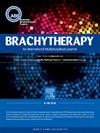The impact of inherent dose heterogeneity of brachytherapy on calculating iso-effective dose-fractionation regimens for nonmelanoma skin cancers
IF 1.7
4区 医学
Q4 ONCOLOGY
引用次数: 0
Abstract
PURPOSE
Utilizing equivalent uniform biologically effective dose (EUBED) concept to calculate iso-effective dose-fractionation regimens in nonmelanoma skin cancer high-dose-rate (HDR) brachytherapy (BT) to address dose heterogeneity and comparing it with the simple form of biologically effective dose (BED) formula.
METHODS AND MATERIALS
Two hypothetical HDR BT treatment plans were created for surface and interstitial techniques. Then iso-effective dose-fractionation regimens were calculated (with both EUBED and BED equations) to prescribe a total EQD210 (equivalent dose in 2 Gy fractions with α/β = 10Gy) of 56, 60 and 65 Gy to the planning target volume (PTV) over a range of five to fifteen fractions. Three different treatment schedules were considered: two and three fraction per week for surface BT and two times a day for interstitial BT. If the treatment duration exceeded 1 month (Tk = 28 days), tumor repopulation was taken into account. Other radiobiological parameters used were α/β = 10Gy, α = 0.3Gy-1, and Tp = 4 days. Finally, the dose per fraction calculated in the EUBED method was compared with the simple form of the BED formula.
RESULTS
The BED formula, compared to the EUBED equation, may lead to less than 5% overestimation in the calculated dose per fraction. This difference is more noticeable in surface BT compared to interstitial implants, especially when prescribing lower total doses, when the total treatment duration in surface BT approaches 28 days, and when using more fractionated interstitial BT treatment regimens.
CONCLUSIONS
Based on the findings of this study, dose distribution inhomogeneity in nonmelanoma skin cancer HDR brachytherapy has minimal clinical impact on calculating iso-effective dose-fractionation regimens.
近距离放射治疗的固有剂量异质性对计算非黑色素瘤皮肤癌等效剂量分次方案的影响。
目的:利用等效均匀生物有效剂量(EUBED)概念计算非黑色素瘤皮肤癌高剂量率(HDR)近距离放射治疗(BT)的等有效剂量分割方案,解决剂量异质性问题,并将其与简单形式的生物有效剂量(BED)公式进行比较。方法和材料:对表面和间隙技术创建了两种假设的HDR BT处理方案。然后计算等效剂量分馏方案(使用EUBED和BED方程),规定总EQD210 (2 Gy分数的等效剂量,α/β = 10Gy)在5到15个分数范围内达到计划目标体积(PTV)的56、60和65 Gy。考虑了三种不同的治疗方案:表面BT每周两次和三次,间质BT每天两次。如果治疗持续时间超过1个月(Tk = 28天),则考虑肿瘤再增殖。其他放射生物学参数为α/β = 10Gy, α = 0.3Gy-1, Tp = 4天。最后,将EUBED方法计算的每组分剂量与简单形式的BED公式进行比较。结果:与EUBED公式相比,BED公式在每组分计算剂量上可能导致小于5%的高估。与间质植入相比,这种差异在表面BT中更为明显,特别是当处方总剂量较低、表面BT的总治疗时间接近28天时,以及使用更分散的间质BT治疗方案时。结论:基于本研究的结果,非黑色素瘤皮肤癌HDR近距离放射治疗的剂量分布不均匀性对计算等有效剂量分割方案的临床影响很小。
本文章由计算机程序翻译,如有差异,请以英文原文为准。
求助全文
约1分钟内获得全文
求助全文
来源期刊

Brachytherapy
医学-核医学
CiteScore
3.40
自引率
21.10%
发文量
119
审稿时长
9.1 weeks
期刊介绍:
Brachytherapy is an international and multidisciplinary journal that publishes original peer-reviewed articles and selected reviews on the techniques and clinical applications of interstitial and intracavitary radiation in the management of cancers. Laboratory and experimental research relevant to clinical practice is also included. Related disciplines include medical physics, medical oncology, and radiation oncology and radiology. Brachytherapy publishes technical advances, original articles, reviews, and point/counterpoint on controversial issues. Original articles that address any aspect of brachytherapy are invited. Letters to the Editor-in-Chief are encouraged.
 求助内容:
求助内容: 应助结果提醒方式:
应助结果提醒方式:


